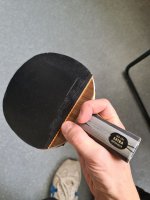This user has no status.
This user has no status.
Member
After 2 years of training, I impoved a lot and now I play in Division 1 of my local league instead of division 3. But somehow I felt my backhand has always been my weakness and it stopped me from improving further. I have spent a lot of time practicing Penhold reverse backhand. I use RPB exclusively now and never use the troditional backhand. In training, I did ok and I can top spin against top/back spin balls with RPB. But in real matches, it is just not very effectie.
My defence in bachand is quite weak, and I made too many unforced errors with backhand too. To win I have to run about to use my forehand only. I felt a lot of the time, I lost the match because I have disadvange in my style to start with. Somtimes, my opponent just push long to my backhand n I can't do anything with it.
I have tried shakehand couple of times recently, and I found my forehand is nearly the same as penhold, maybe even slightly more powerful. My backhand is more natrual and it is much faster to set up top spin comparing with RPB. I can hit some powerful shots with backhand. The blocking is easier too.
My big question is, shall I abandon the style that I loved and been practiced for years, and change to skakehand instead?
Thanks in advance.
My defence in bachand is quite weak, and I made too many unforced errors with backhand too. To win I have to run about to use my forehand only. I felt a lot of the time, I lost the match because I have disadvange in my style to start with. Somtimes, my opponent just push long to my backhand n I can't do anything with it.
I have tried shakehand couple of times recently, and I found my forehand is nearly the same as penhold, maybe even slightly more powerful. My backhand is more natrual and it is much faster to set up top spin comparing with RPB. I can hit some powerful shots with backhand. The blocking is easier too.
My big question is, shall I abandon the style that I loved and been practiced for years, and change to skakehand instead?
Thanks in advance.
Last edited:











